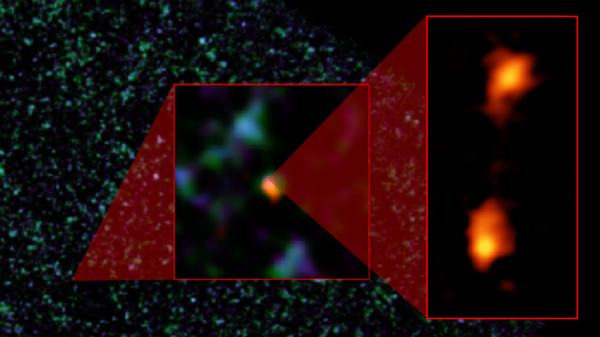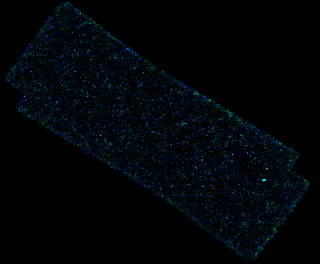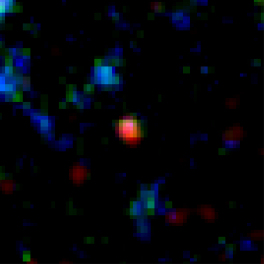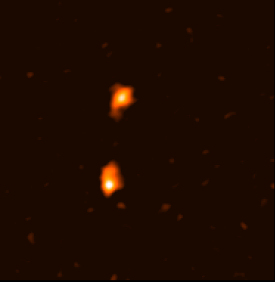Herschel discovers galaxy merger in the very early Universe
13 November 2017
What seemed at first like a rare instance of a huge, ancient galaxy revealed itself to be an even rarer pair of extremely massive galaxies, seen on the brink of merging when the Universe was only a billion years old. |
| Merging galaxies. Credit: NRAO/AUI/NSF, B. Saxton; ESA/Herschel; ESO/APEX; ALMA (ESO/NAOJ/NRAO); D. Riechers et al. 2017 |
This outstanding source was first identified by ESA's Herschel space observatory, and later exposed in greater detail with the ground-based Atacama Large Millimeter/submillimeter Array (ALMA) in Chile.
The earliest galaxies in the 13.8 billion-year history of our cosmos started to take shape a few hundred million years after the Big Bang, as matter flowed towards increasingly denser spots and as the first stars were igniting into life.
Primordial galaxies, however, were not like the ones we are familiar with today. They started out much smaller than our Milky Way galaxy, which is now home to hundreds of billions of stars, and slowly grew more massive over billions of years.
In this scenario, astronomers could not easily explain the observation of massive galaxies populated by ageing stars at relatively early epochs in cosmic history, when the Universe was only a few billion years old.
How did such massive galaxies assemble in this relatively short time?
| Merging galaxies in the early Universe. Click here for details and large versions of the video. Credit: ESA/Herschel; ESO/APEX; ALMA (ESO/NAOJ/NRAO); D. Riechers et al. 2017 |
The recent discovery of possible progenitors to such galaxies – massive galaxies observed at even earlier cosmic times – has brought new clarity to these investigations.
"Scrutinising several hundred thousand galaxies observed by Herschel, we identified a very rare instance of a massive object in the very early Universe," says Dominik Riechers from Cornell University, USA, who is the lead author of the new study.
The wide range of infrared and submillimetre wavelengths probed by Herschel, which scanned the sky between 2009 and 2013, was key to finding this source.
Galaxies that are forming stars shine brightly in the infrared. This is due to cosmic dust present in the dense clouds where stars are born, which absorbs part of the starlight and radiates it again at longer wavelengths.
In addition, because the Universe is expanding, the wavelength of light emitted by distant galaxies is stretched even longer along its cosmic journey, up to the submillimetre in the case of the most distant galaxies, whose light was released in the first few billion years of cosmic history.
 |
 |
| Herschel's survey of galaxies. Credit: ESA/Herschel; ESO/APEX; D. Riechers et al. 2017 | A rare system in the very early Universe. Credit: ESA/Herschel; ESO/APEX; D. Riechers et al. 2017 |
It was 2012 when Dominik and colleagues singled out this source as potentially interesting and worthy of follow-up observations. After they looked at it at even longer submillimetre wavelengths with Europe's Atacama Pathfinder Experiment (APEX), also located in Chile, it stood out as the 'reddest' in this galaxy sample, appearing consistently brighter at increasingly longer wavelengths, up to 870 micron.
This suggested that the galaxy is ripe with star formation and located at a great distance from us, in the depth of the very early Universe.
Using further observations obtained with ALMA, the astronomers spotted carbon monoxide and water vapour in this object, and used these emissions to estimate how far away it is from us. This confirmed that they were observing the source as it was only a billion years after the Big Bang.
The high-resolution observations performed with ALMA had an extra surprise in store.
 |
| ALMA's view of two merging galaxies in the early Universe. Credit: ALMA (ESO/NAOJ/NRAO); D. Riechers et al. 2017 |
"On closer inspection, this unique object was even more exciting than we could expect, consisting not just of one ancient, massive galaxy, but of a pair of distinct massive galaxies about to merge," explains Dominik.
These two galaxies, each roughly as massive as our Milky Way, were informally dubbed the 'Horse' and the 'Dragon'.
Teeming with star formation, they are 10 to 100 times more massive than most galaxies at the same epoch in the Universe's history. The Horse and the Dragon will eventually come together, giving rise to an even more massive galaxy in a few hundred million years' time.
The finding demonstrates that giant galaxies, albeit rare, did exist at very early cosmic epochs and could well be the progenitors of the massive ones harbouring ageing stars that are observed at slightly later times, when the Universe's age was only a couple billions of years.
The team is now busy investigating this extreme merging system in even greater detail, studying the properties of its stellar population and dust with ALMA as well as with the European Southern Observatory's Very Large Telescope.
"We are also looking for possible satellites, smaller galaxies that might have been caught in the gravitational field of the two behemoths, as we would expect from theory," says Dominik.
In the near future, observations with the NASA/ESA/CSA James Webb Space Telescope, to be launched in 2019, will allow astronomers to delve deeper into the secrets of this system.
Further into the future, there will be an additional tool to investigate the early Universe through galactic mergers – though only those at a much more advanced stage than the Horse and the Dragon, when the supermassive black holes at the centre of each galaxy are about to coalesce. Such cosmic collisions release gravitational waves – fluctuations in the fabric of spacetime – that can be observed by ESA's future gravitational wave observatory, LISA.
In the meantime, it is unlikely that many more systems like the one recognised by Dominik and his collaborators will be uncovered. If current theories about galaxy formation are correct, such beasts are extremely rare. Nevertheless, the team will keep investigating data from the Herschel archive for possible evidence of other interesting sources.
"This exciting result, obtained by thoroughly combing through Herschel's surveys combined with extensive follow-up observations, demonstrates the powerful legacy and long-term impact of the data now, several years after the observing was done," says Göran Pilbratt, Herschel project scientist at ESA.
"This will continue to be the case for many years."
Notes for Editors
"Rise of the titans: a dusty, hyper-luminous '870 μm riser' galaxy at z~6," by D. Riechers et al. is published in the Astrophysical Journal, 13 November 2017.
ALMA is an international astronomy facility, and a partnership between the European Southern Observatory, the US National Science Foundation and the National Institutes of Natural Sciences of Japan in collaboration with the Republic of Chile. More about ALMA partners.
For further information, please contact:
Dominik Riechers
Cornell University
Ithaca, NY, USA
Tel: +1 607 255 3989
Email: riechers![]() astro.cornell.edu
astro.cornell.edu
Göran Pilbratt
Herschel Project Scientist
Directorate of Science
European Space Agency
Tel: +31 71 565 3621
Email: gpilbratt![]() cosmos.esa.int
cosmos.esa.int
Markus Bauer
ESA Science Communication Officer
Tel: +31 71 565 6799
Mob: +31 61 594 3 954
Email: markus.bauer![]() esa.int
esa.int





